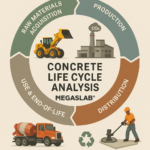Concrete slabs serve as the solid foundation for various structures, supporting not only the weight of the building but also heavy equipment, machinery, and dynamic loads. A well-designed concrete slab ensures safety, functionality, and longevity. Here’s a comprehensive guide on designing the ideal concrete slab for heavy equipment while incorporating key industry terms and concepts.
Understanding the Basics of Concrete Slabs
A concrete slab’s primary purpose is to provide a stable and load-bearing surface. Several critical factors influence the design:
- Soil Type and Load Capacity: The soil’s load-bearing capacity is paramount. Different soil types have varying abilities to support heavy loads, and a thorough soil analysis by a professional engineer is essential.
- Equipment Type and Size: The type and size of heavy equipment play a crucial role. Consider the differences in load distribution between a forklift and a heavy truck.
- Anticipated Traffic: The frequency and type of traffic, whether foot traffic or machinery, must be taken into account during the design phase.
- Foundation Options: Depending on the site and its requirements, options such as a foundation stem wall or pole barn may be considered for added support and stability.
Determining the Thickness
The thickness of the concrete slab is a critical factor in its ability to support heavy loads and dynamic forces. Key considerations include:
- Deflection and Bending: These factors relate to how much a slab will flex under the applied load. Excessive deflection can lead to instability.
- Shear Strength: Ensuring adequate shear strength is essential to prevent slab failure.
- Compressive Strength: The slab’s ability to withstand compressive forces is a crucial factor, particularly when dealing with heavy loads.
- Fire Resistance: In certain settings, fire resistance is crucial. A thicker concrete slab can enhance fire resistance.
Thickness Recommendations for Heavy Equipment
When dealing with heavy equipment, specific thickness guidelines should be followed:
- General Recommendations: Ideally, areas where heavy machinery operates should have a thickness of at least six inches, while four inches may suffice for lighter loads.
- Commercial Spaces: For retail or commercial concrete slabs, thickness typically ranges between 4 and 6 inches. However, a thinner slab may lead to safety hazards and increased maintenance costs.
- Industrial Strength: In industrial settings where machinery carries extremely heavy loads, a thicker slab, potentially up to 12 inches, may be necessary for optimal performance and safety.
Warehouse Floor Considerations
Designing warehouse floors requires special attention, as they often face dynamic loads and high traffic:
- Dynamic vs. Static Loads: Warehouse floors must be designed to handle both dynamic loads from moving machinery and static loads from stored items.
- Crack Prevention: To ensure safety, it’s essential to use the right concrete mix, proper reinforcement, curing methods, and appropriate control joints to prevent cracks.
- Reinforcement Options: Consider using techniques such as rebar or wire mesh for added structural integrity, especially in areas with heavy traffic.
The Importance of Floor Thickness
Concrete slab thickness affects more than just structural integrity:
- Sound and Vibration Absorption: A thicker industrial concrete floor provides better insulation against sound, making for a quieter working environment. It also absorbs vibrations more effectively, reducing wear and tear on machinery.
- Thermal Insulation: Thicker floors prevent heat from escaping, contributing to improved energy efficiency in buildings.
- Specialized Applications: In settings like small airports, where heavy loads from aircraft are common, or on city streets subject to freeze-thaw cycles, a thicker concrete surface may be necessary for durability.
Industrial Concrete Floors
Industrial settings often demand extremely durable flooring solutions:
- General Thickness: Industrial concrete floors are typically a minimum of 4 inches thick but may require up to 12 inches, depending on the weight they will bear.
- Chemical Resistance: In environments exposed to chemicals, additional considerations for cement type and surface treatments are necessary to ensure durability.
- Maintenance Planning: Due to the harsh conditions, maintenance plans for industrial floors should be well-defined to ensure longevity.
Concrete Slab Foundations Pros
Concrete slab foundations offer several advantages:
Strength and Durability: They provide a robust and long-lasting foundation suitable for areas with high foot traffic or challenging digging conditions.
Maintenance: Concrete slabs require less maintenance than other foundation types, making them cost-effective in the long run.
Load Capacity: Properly designed and reinforced concrete slabs can handle significant load capacity, making them suitable for various applications, including existing industrial buildings and new construction.
Choosing the Right Concrete Slab for Your Heavy Equipment Facility
Selecting the appropriate concrete slab for your heavy equipment facility is a critical decision that can significantly impact safety, functionality, and long-term cost-effectiveness. Here are essential considerations for choosing the right concrete slab for your specific heavy equipment needs.
Assessing Heavy Equipment Requirements
Before diving into the details of concrete slab selection, it’s crucial to assess your heavy equipment facility’s specific requirements:
- Equipment Types and Loads: Begin by identifying the types and sizes of heavy equipment that will operate on the slab. Different equipment exerts varying loads, so understanding these specifics is paramount.
- Dynamic vs. Static Loads: Distinguish between dynamic loads (caused by moving equipment) and static loads (due to stationary equipment or stored materials). Your slab design must accommodate both types effectively.
- Anticipated Traffic Patterns: Consider the flow of equipment and personnel within the facility. This includes entry and exit points, turning radii, and high-traffic areas.
Determining Slab Thickness
The thickness of the concrete slab is one of the most critical factors in ensuring it can withstand the demands of your heavy equipment facility. Here’s how to determine the appropriate thickness:
- Load-Bearing Analysis: Conduct a thorough analysis of the soil’s load-bearing capacity at your site. This analysis should be performed by a professional engineer who can provide precise data for your specific location.
- Heavy Equipment Load Distribution: Understand the weight distribution of your heavy equipment, including wheel loads, axle loads, and any concentrated loads. This information will help you calculate the required slab thickness.
- Comprehensive Design: Work with engineers to create a comprehensive slab design for deflection, shear strength, and compressive strength. These considerations are vital for structural integrity.
- Minimum Thickness Guidelines: Adhere to industry guidelines for minimum slab thickness based on your heavy equipment’s weight and traffic patterns. Keep in mind that thicker slabs provide better long-term performance and safety.
Specialized Requirements
Depending on your heavy equipment facility’s specific needs, you may encounter specialized requirements:
- Pole Barn Foundations: If your facility includes pole barns, consider how the concrete slab interfaces with the foundation stem wall or other structural elements.
- Industrial Settings: In industrial settings, where equipment may carry extremely heavy loads or encounter harsh chemicals, you might need thicker slabs (up to 12 inches) and additional chemical resistance measures.
- Control Joints: Properly placed control joints are essential for minimizing the risk of cracking, especially in areas subjected to heavy loads and temperature variations. To gain a comprehensive understanding of concrete deterioration and its solutions, which is crucial in heavy equipment environments, read about concrete deterioration: causes and solutions.
- Reinforcement: Assess whether your design requires reinforcement options such as rebar or wire mesh to enhance the slab’s structural integrity, particularly in high-traffic zones.
Long-Term Considerations
When selecting the suitable concrete slab for your heavy equipment facility, think about the long-term implications:
- Maintenance Planning: Develop a comprehensive maintenance plan that includes regular inspections, repairs, and maintenance to extend the slab’s lifespan.
- Energy Efficiency: Consider the thermal insulation properties of your slab. A thicker slab can help maintain indoor temperatures efficiently, potentially reducing heating and cooling costs.
- Durability and Safety: Prioritize durability and safety in your design to minimize accidents, equipment damage, and costly repairs.
- Environmental Factors: Evaluate how local climate conditions, including freeze-thaw cycles, may affect your slab’s performance. Proper construction methods can mitigate these effects.
Choosing the right concrete slab for your heavy equipment facility is a complex but crucial decision. By thoroughly assessing your equipment’s requirements, understanding load-bearing capacities, considering specialized needs, and planning for the long term, you can ensure that your concrete slab not only supports heavy loads but also contributes to the overall success and safety of your facility. Collaborating with experienced engineers and construction professionals is essential to achieve the best results for your specific project. Learn about the advanced solutions offered by MEGASLAB patented technology that can enhance the performance and durability of concrete slabs in heavy equipment facilities.
Whether supporting heavy loads in a warehouse, providing a solid foundation for a pole barn, or ensuring the durability of an industrial floor, a well-designed concrete slab is the cornerstone of many construction projects. By following recommended guidelines and working with experienced engineers and builders, you can design and create concrete slabs that stand the test of time and support the heaviest of equipment.




